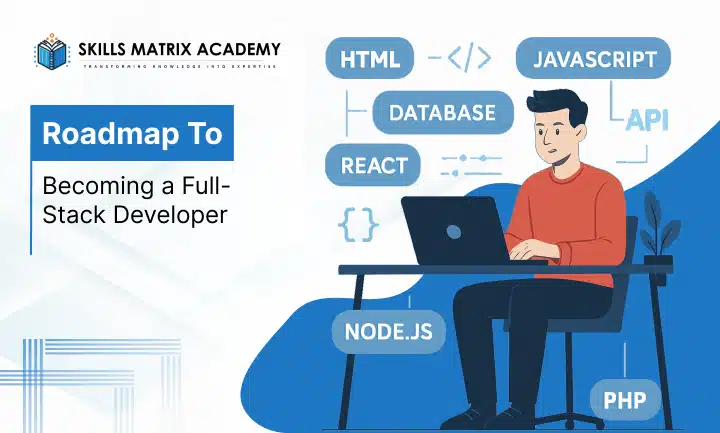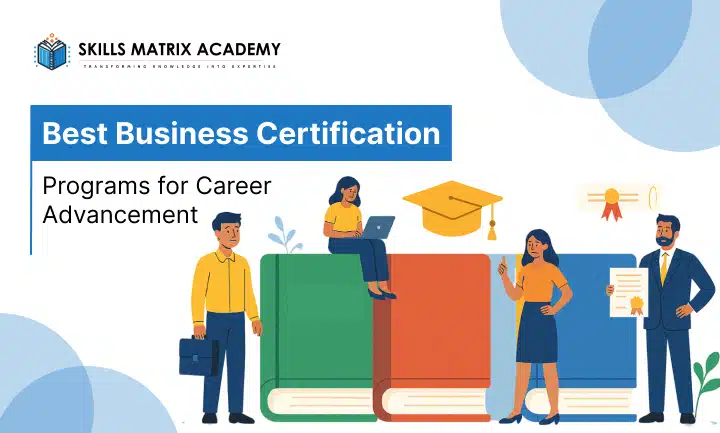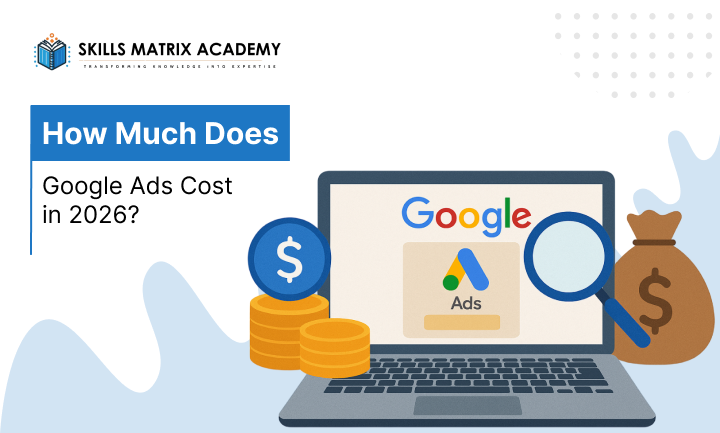Ever wondered how websites and apps are made? It’s not magic — it’s a simple, step-by-step process. From choosing the right tech stack in a full-stack web development workflow to following best practices in website development, each step transforms ideas into user-friendly digital products. Skilled full-stack developers work on everything — from front-end interfaces users see, to back-end servers that keep things running smoothly.
If you want to build these skills, a full-stack developer course is the perfect place to start. It teaches you how to create robust digital solutions from scratch. Website development courses also help you master creating engaging, high-performance sites. By learning full-stack web development, you open doors to exciting careers and get the chance to build the platforms shaping modern life. Now is the best time to start your journey of learning a full-stack development course with the right full-stack developer course.
What is Full Stack Web Development?
Full-stack web development refers to the technology or a process of constructing a whole website, and this involves constructing both, the visual (the front end) and the functionality (the back end) of a website or application. The front end covers everything users visually experience — from the design and layout to buttons, menus, and other interactive elements. The back end, on the other hand, operates out of sight, managing the logic, databases, and server processes that make the front end function seamlessly. Many students and professionals focus only on one side of web creation. However, learning full-stack web development gives you the skills to handle both — from designing and testing to delivering fully functional web pages. This makes you more versatile and capable of completing entire projects without relying on multiple specialists.
Today, almost all industries are dependent on full-stack development to create a platform for customer-intraction as well as for internal websites and applications. Whether you want to work for a company or start your own projects, mastering both the front end and back end will give you a competitive edge. Enrolling in a website development course or a full-stack developer course is the best way to gain these in-demand skills and start building robust digital solutions.
Your Guide to Becoming a Full Stack Developer – From Beginner to Pro
To grow as a full-stack developer, you need to master some skills, which mainly includes technical skills along with a structured project-based learning, and a portfolio that showcases all your skills. Follow this roadmap to take clear, actionable steps toward your career in web development.
1. Start With a Foundation Course
- No coding experience? No problem.
- Begin with a beginner-friendly full-stack developer course that covers the basics in 4–6 weeks.
- Choose one that offers mentors and career guidance — this early support can make a big difference in your job search.
2. Choose Your Learning Path
There’s more than one way to become a full-stack developer. Pick what fits your goals:
- University Degree – Traditional route, usually in computer science or software engineering.
- Self-Taught – Flexible but challenging. Use free resources and paid resources, study code on GitHub, and follow structured roadmaps online.
3. Learn the Core Programming Languages and Tools
- Languages – Begin with JavaScript, then move on to frameworks like React and Node.js. Add Python, PHP, or C#, depending on your interest.
- Use tools like Visual Studio Code, command-line interfaces, databases, and Git/GitHub to manage version control effectively.
4. Build Real Projects to Grow Your Skills
- Go beyond theory — build real projects.
- Develop interactive front-end elements and connect these with back-end servers and databases.
- Deploy using Heroku or Netlify to make your work live and shareable.
5. Strengthen Your Portfolio With Practical Work
- Volunteer for real-world projects.
- Contribute to open-source communities or take on freelance gigs.
- Join hackathons or coding challenges to test your skills and create portfolio-worthy projects.
6. Find a Mentor
- An experienced mentor can support you with expert advice, right career direction, and proper encouragement.
- Build relationships naturally through courses, events, or workplaces — instead of cold messaging strangers.
7. Practice Coding Every Day
- Daily practice coding keeps your skills sharp.
- Prep for technical interviews using platforms like LeetCode, HackerRank, or CodeSignal.
Benefits of Learning Full Stack Web Development
-
Keep Current in an Evolving Industry
Learning full-stack web development lets you work with the latest technologies and widely accepted industry tools. This helps you stay up to date in an ever-changing tech landscape and stay relevant as the industry evolves.
-
Apply an In-Demand Skill Professionally
With full-stack development skills, you can qualify for many tech roles and apply your knowledge professionally. While AI might disrupt some areas of web development, the human element will always be essential in many positions.
-
Be Your Boss
Full-stack development lets you handle every stage of website creation and app creation—from front-end development to back-end development. You can meet client needs, work independently, be less reliant on others, and take full ownership of your projects.
Skills Needed to Become a Full-Stack Developer
Becoming a great full-stack developer means balancing deep technical knowledge with effective teamwork and adaptability. These will help you build, deploy, and manage complete web applications while being able to collaborate smoothly with others.
Technical Skills
These are the must-have abilities every full-stack developer should master:

-
JavaScript and Frameworks
- Be proficient in JavaScript. Use different version controls like- GitHub to manage code, to collaborate with developers world-wide, and track your project changes efficiently.
- Learn popular frameworks and libraries like React (front-end), Node.js, and Express.js (back-end).
- Learn to integrate third-party APIs.
-
Database Management
- Have a solid understanding of SQL databases like PostgreSQL and MySQL, along with NoSQL databases such as MongoDB.
- Understand storing and managing data efficiently.
-
Version Control with Git
- Use different version controls like- GitHub to manage code, to collaborate with developers world-wide, and track your project changes efficiently.
-
Web Hosting and Deployment
- Get comfortable hosting and deploying apps on Heroku, Netlify, AWS, or Azure.
- Learn how to scale applications for more users.
-
UI/UX Principles
- Understand UI principles and UX principles.
- Build user interfaces that are intuitive and responsive, even if you’re not a designer.
Soft Skills
Technical know-how isn’t enough. These soft skills keep you effective in real-world projects:
- Communication
- Explain technical concepts clearly to non-technical stakeholders.
- Work well with cross-functional teams.
- Adaptability
- Be prepared to switch your tasks between front-end and back-end.
- Be open to change and continue learning to stay relevant and practical.
- Problem-Solving
- Tackle debugging code, optimising performance, and making architecture decisions.
- Use critical thinking and analytical abilities to find the best solutions.
- Project Management
- Prioritise tasks, meet deadlines, and manage workflows.
- Lead or work independently to deliver results throughout your career.
Full-Stack Developer Roadmap: Landing a Job
Once you’ve built your solid technical foundation and created a strong portfolio which includes various real life projects, the next step is to land a high paying job into the industry.
This full-stack developer course will help you turn your skills into a full-time role.
1. Maintain a Strong GitHub Profile
Your GitHub profile is like a public resume and portfolio combined. Many employers check it to see your code quality, consistency, and project documentation. To stand out:
- Keep repositories well-organised with clear naming conventions.
- Add descriptive README files explaining what the project does, how to run it, and what tools were used.
- Commit regularly with meaningful commit messages that show your thought process.
Pro Tip: Treat GitHub like your portfolio storefront—only your best work should be in the shop window.
2. Start Networking Early
Networking builds your professional network and opens opportunities you might never see otherwise. Start by:
- Creating a polished LinkedIn profile showcasing your projects and learning journey.
- Attend technology meetups, coding competitions, and virtual conferences to expand your professional network.
Pro Tip: Don’t wait until you need a job—start contributing, asking questions, and helping others now to build strong relationships.
3. Pursue an Internship (If Possible)
An internship provides hands-on experience and industry exposure, making it particularly valuable if you’re transitioning from another field. Many lead to full-time roles.
If you can’t land a traditional internship:
- Look for remote, part-time, or even unpaid opportunities.
- Consider apprenticeship programs or open-source projects that involve working with real teams.
4. Tailor Your Resume and Start Applying
When you’re ready to start applying:
- Customise your resume for each job description by adding the right keywords and technologies.
- Highlight projects (especially ones with real users or stakeholders), not just coursework.
- Include links to your GitHub, personal site, and deployed applications.
Pro Tip: Prepare for both behavioural interview questions and technical interview questions. Use various platforms to prepare for your coding interview, like LeetCode and Pramp.
The Timeline for Learning Full Stack Web Development
The time it takes to learn a full-stack web developer course mostly depends on your background and how you define “mastery.” If you already understand front-end development and only need to pick up back-end skills, your learning process will usually be quicker. However, if you’re a complete beginner with no experience in either area, it will naturally take more time to learn.
For those with a technical background—especially if you’re already familiar with programming or website development basics—you can grasp key concepts in just a few weeks through full-stack web development courses. Still, becoming an expert requires patience. To become highly skilled in the field, you’ll often need a formal degree and/or solid experience building websites from the ground up.
Pro Tip: Learning a full-stack developer course is like learning a new language—you can start speaking it within weeks, but mastering it requires years of practice, hands-on projects, and real-world experience.
Resources for Full-Stack Development Jobs
If you’re hunting for a full-stack developer job, here are the best places to search:
-
LinkedIn
LinkedIn is a valuable resource full of career tips and job listings. Make it your first stop when looking for full-stack developer jobs.
-
Job Boards
Explore well-known job sites such as Stack Overflow, Dice.com, AngelList, F6S, and Mashable for job opportunities. They list many full-stack developer job opportunities.
-
Network
Let your professional contacts know you’re job hunting. They can refer you and help your resume stand out more quickly.
-
Slack Communities
Join Slack channels like #DevChat to connect with full-stack developers, along with this you should explore specialised programming groups like PySlackers, and Elm to increase your professional networks and be updated of regular new job openings.
FAQs on Becoming a Full-Stack Developer
Q1. Can anyone become a successful full-stack developer without any degree?
Ans. Yes! Completing a full-stack developer course or bootcamp can prepare you for entry-level roles.
Q2. Is Full-Stack Development Stressful?
Ans. It can be. Full-stack roles sometimes involve tight deadlines and are fast-paced. Some people handle this well, while others may find it challenging—it depends on your training, understanding and skills.
Q3. Is it really Hard to Become an Expert Full-Stack Developer?
Ans. Not if you have a clear plan. Whether you choose a college degree, bootcamp, or self-taught route, make sure your plan is realistic. Also, think about your strengths—whether starting with front-end or back-end development makes more sense for you.
Q4. Do Full-Stack Developers Get Paid More?
Ans. Full-stack developers have better salary prospects than those specialising only in front-end or back-end development. However, this salary gap often becomes noticeable only after some years into your career.










